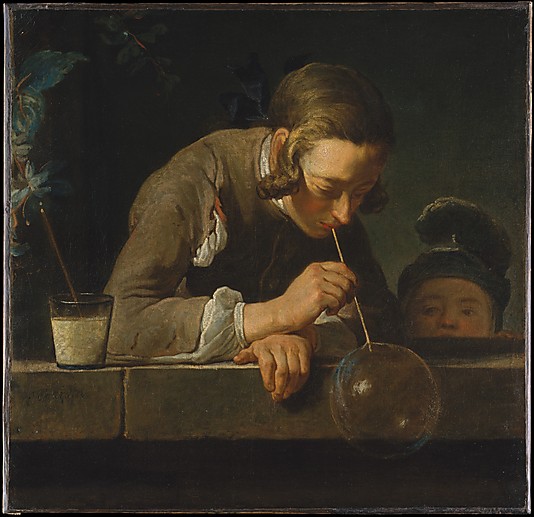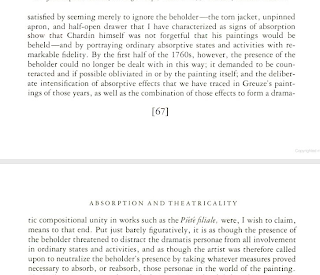Art historian Michael Fried's 1980 book Absorption and Theatricality is about how French painters in the late 18th century started to paint people who are totally absorbed in the moment -- engrossed in what they are doing and oblivious to the possibility that they could be observed (by, say, the person looking at the painting). Fried tries to figure out why viewers of the time had such a taste for this. What made the experience of looking at someone who appeared oblivious to their presence so compelling? And was it any different from simple voyeurism? What, if anything, did it have to do with, say, the spread of literacy and of private solitary reading as a familiar and pleasurable experience?
Since we are currently acclimating ourselves to a new culture-sweeping technology for self-absorbed pleasure, these struck me as interesting questions. As Nathan Jurgenson has argued, social media make our awareness of the possibility of self-documentation a central feature of consciousness, which makes absorption of the kind Chardin specialized in depicting difficult for us to experience. We are removed from the present moment and always potentially spectators of ourselves, wondering how what we are doing might play in the future in some other medium. We may become nostalgic for the possibility of true absorption in experience, or even in a book.
This heightened self-consciousness and constant awareness of the demands strategic self-presentation robs us of our sense of personal authenticity. Social media can makes us all too aware of how calculating we might seem to others and presents us with the unsolvable problem of how to convey our truly genuine interest in something without it coming across as a convenient or tactical pose. The space in which we can experience ourselves just being ourselves disappears.
These aren't exactly the sort of spaces Fried highlights in French painting, but they are similar. A version of this authenticity problem haunted the late 18th century imagination as well (certainly Diderot and the other French art critics Fried discusses), as the perception of everyone's calculating self-interestedness was being sharpened by the rise of capitalism and the emergence of a socially mobile middle class. The erosion of tradition -- the rise of social mobility -- made ritualized emotional displays suddenly suspect. They became a politicized point of class conflict between aristocrats and the rising bourgeoisie. Who exhibited "real" taste and feeling, and who was decadent or false? Was their "heart" in the right place, these nouveau riches? Who among them were undeserving social climbers, greedy opportunists, and who were the ones with feeling hearts, with true moral sensibility? That kind of question led to brief efflorescence of the "cult of sensibility" — a fascination with public crying and other outward signs of "true feelings" and a finely tuned internal moral responsiveness.
But this quickly degrades into vitiating autosurveillance as well. You can see a reflection of this in Adam Smith's Theory of Moral Sentiments, which bases morality on our capability of vicariously experiencing others' feelings. According to Smith, our own feelings are invariably mixed up with what we perceive of others' feelings, so essentially we have an inescapable interest in the emotional lives of everyone else.
How selfish soever man may be supposed, there are evidently some principles in his nature, which interest him in the fortunes of others, and render their happiness necessary to him, though he derives nothing from it, except the pleasure of seeing it. Of this kind is pity or compassion, the emotion we feel for the misery of others, when we either see it, or are made to conceive it in a very lively manner. That we often derive sorrow from the sorrows of others, is a matter of fact too obvious to require any instances to prove it; for this sentiment, like all the other original passions of human nature, is by no means confined to the virtuous or the humane, though they perhaps may feel it with the most exquisite sensibility. The greatest ruffian, the most hardened violator of the laws of society, is not altogether without it.
Since how we all affect each other by the kind of feelings we display, it behooves us to imagine someone is always watching us, and to act with that cool impartial observer's likely reactions in mind.
You can see the ideological justification of social media embedded in this as well: other people's happiness must be shared more widely so as to give observers the necessary "pleasure of seeing it." But as Smith's examples show, he wasn't thinking about the circulation of "likes" for well-groomed self-representations; he was thinking about seeing people in the street suffer and feeling moved to do something about it. We are improved morally when society "shares" with us images that move us emotionally, when we see genuine suffering and respond with a genuine sympathy in turn.
But the genuineness was always problematic. Sensibility ultimately became mannered, stylized — as in the work of one of Fried's main subjects, Jean-Baptiste Greuze. Sensibility became a matter of spectatorship and reaction to formulaic cues -- which is what relates it to the modern entertainment industry, which thrives of passive spectatorship and the delectation of contrived emotional experiences for their own sake. Novels, which became a standardized cultural product around this time, capitalized on the public's eagerness for opportunities to demonstrate a "feeling heart," offering fictional characters' sufferings to test readers' emotional intelligence. Were these genuine experiences? Weeping over a book, for a time, seemed to serve as proof of one's goodness, and but it was all too easy (and satisfying, as Smith suggested) to let the novel provoke sympathetic tears and prove your inner worth — a process which in turn provoked much mockery from proto-romantic skeptics. (Romanticism evolves out of the cult of sensibility by fusing a critique of sensibility's formulas with a contempt for its bourgeois adherents.)
Every aspiring novelist, and readers too, learned the grammar of emotional prose, the key words and scenarios which were to trigger certain feelings; painting seems to have been similarly afflicted. The shift Fried details in the excerpt below (sorry about the Google Books screen shots) gets at how representations of reflexivity can become suddenly loaded and problematic for a society. The ability to let go of oneself can be reified and neutralized, circumscribed -- or it may be glamorized and disseminated as an ideal.
That absorption -- the antithesis of self-conscious reflexivity -- can itself become a self-conscious artistic trope that appealed deeply to critics like Diderot, who were so concerned about the corruption of spontaneous emotion, suggests something about our own era and the threats it poses to spontaneity.
For Diderot, authentically affecting scenes were no longer the ones that depicted vivid violence or naked suffering or anything else that might seem too theatrical, but instead subtler scenes of quiet contemplation. These allow viewers to forget they are outside the painting, observing. They can therefore project themselves imaginatively into the space of the painting, echoing the feat of sympathy Smith championed. You get to forget yourself, at last, just like the figures in the painting, and forget all about the calculatedness of your own emotionality. You become genuine when the painting sucks you in.
The escape from self-consciousness has long been an attractive fantasy, one that defies being represented without being turned into its opposite, strategic deployment of the signs of absorption. And that invokes not escape but the prison-house of ubiquitous lateral surveillance. Fried describes how painters began to try to deliberately negate the presence of the observer and make the escape from surveillance part of the depicted reality of their works:
So certain stylized representations of absorption negate the distracting and disrupting presence of the ever-implied observer. When Greuze's melodramatic paintings unfold before our eyes as if we are not there, the thrill can be akin to confessional behavior in social media making us into voyeurs. Fried ponders the "paradox" of art connoisseurs yearning for paintings that neutralized their presence.
This doesn't seem especially paradoxical to me. The "deep thrill of pleasure" comes from being invisible, which means we are safe to be ourselves, and trust the reality of our own responses. This is the pleasure Smith talked about in observing others with none of the moral correction. Our absorption in the confessional, absorbed behavior of others makes us simultaneously forget ourselves -- the painting effaces us so we can experience the bliss of self-forgetting, which is the only way the true self can appear.
Further, such paintings make us the exception to the general sense of there being no surveillants -- we have our godlike view from a space that is unassimilable to the painted space; we transcend whereas everyone else is imminent and can be denied visual access.
I wonder whether social media could offer at least fleeting experiences of something similar, an illusion of protected solitude that we experience through the procedures of spying. The delusions of access include a sense of personal safety, an exemption by which we protect ourselves against precisely what we do to others. But I think to use social media that way is to cut deeply against the grain of their architecture and requires a resolute stubbornness. Evgeny Morozov's claims about the "the tyranny of the social" in this recent New York Times essay seem closer to the truth than the possibility of escape through online voyeurism. Social media, unlike painting, doesn't encourage a vicarious identification with what they depict; they demand reciprocal participation. Whatever pleasure the experience of the possibility of being ignored once provided has been canceled out by the fear of being excluded, by the fear of not being counted. We don't know ourselves through the quiet moments of contemplation where we suspend our social mimicry; instead we know ourselves when our social striving is represented back to us through social media's scorecard.



